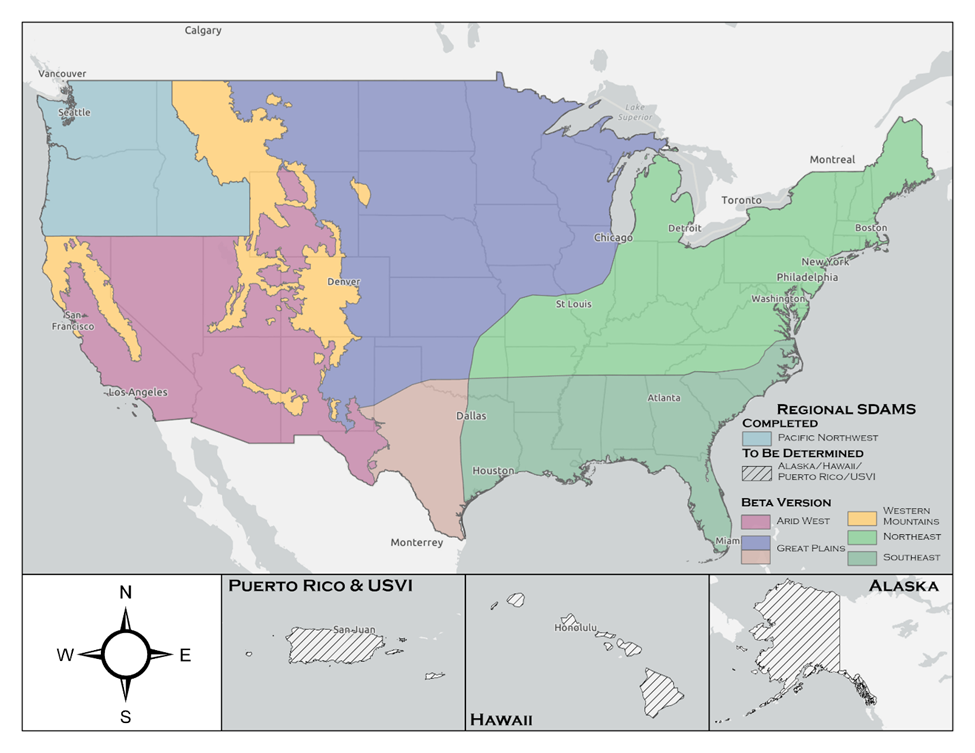Joint Public Notice
The U.S. Army Corps of Engineers (Corps) Baltimore, Buffalo, Charleston, Chicago, Detroit, Fort Worth, Galveston, Huntington, Jacksonville, Kansas City, Little Rock, Louisville, Memphis, Mobile, Nashville, New England, New Orleans, New York, Norfolk, Philadelphia, Pittsburgh, Savannah, St. Louis, Tulsa, Vicksburg, and Wilmington Districts, and the U.S. Environmental Protection Agency (EPA), Regions 1, 2, 3, 4, 5, 6, and 7 jointly announce the availability of the Beta Streamflow Duration Assessment Methods (SDAM) for the Northeast and Southeast (dated April 12, 2023). The methods are rapid assessment tools to help distinguish between ephemeral, intermittent, and perennial streamflow at the reach scale for the Northeast and Southeast SDAM Regions. The beta SDAMs may help provide technical guidance for identifying waters that may be subject to regulatory jurisdiction under Section 404 of the Clean Water Act; however, these methods do not alter or change the definition of “Waters of the U.S.”
These beta SDAMs were developed for use in all or part of the states of Maine, New Hampshire, Vermont, Massachusetts, Rhode Island, Connecticut, New Jersey, Delaware, Maryland, New York, Pennsylvania, West Virginia, Virginia, North Carolina, South Carolina, Georgia, Florida, Louisiana, Alabama, Tennessee, Kentucky, Ohio, Indiana, Arkansas, Kansas, Illinois, Michigan, Missouri, Mississippi, Oklahoma, Texas, and the District of Columbia by the Corps and EPA (Figure 1). Due to differences in climate and a relatively small amount of data points, the Caribbean sites were not used to develop this iteration of the SDAM, nor is the Caribbean covered by the methods. These beta methods result from a literature review and multi-year field study conducted at 336 stream reaches across the range of hydrologic landscapes of the Northeast and Southeast. Developed through statistical analyses of the field data, the beta SDAMs provide a data-driven approach using reliable indicators to determine streamflow duration class at the reach scale. The agencies are making these beta SDAMs available for a one year preliminary implementation and comment period to inform the development of final SDAMs for the Northeast and Southeast.
The beta SDAMs for the Northeast and Southeast can be applied whenever there is uncertainty regarding streamflow duration class and a rapid evaluation method is desired. The methods provide a scientifically supported, rapid assessment framework to support best professional judgment in a consistent, robust, repeatable, and defensible way. Use of the methods may result in timelier and more predictable jurisdictional determinations and are also useful where knowledge of streamflow duration class improves ecological assessment, management, and decision-making. The beta SDAMs were developed specifically from data collected in the Northeast and Southeast.
The methods, data forms, and training opportunities are available on the internet at:
https://www.epa.gov/streamflow-duration-assessment/beta-streamflow-duration-assessment-method-northeast-and-southeast.
Practitioners such as stream ecologists, aquatic ecologists, hydrologists, and wetland scientists are encouraged to comment on their experience using the beta SDAMs. Comments regarding the following specific topics would be especially useful:
- Problem situations encountered and possible approaches for addressing them.
- Seemingly incorrect results, including the factors that suggest the method was inaccurate.
- Indicators that were particularly useful or not useful in identifying flow duration in different hydrological environments.
- Regional differences in the applicability of specific indicators.
- Potential uses of the methods in the regulatory context, or in other watershed planning or management contexts.
Written comments may be submitted via email to USACE.SDAM.NESE@usace.army.mil or by hard copy to: U.S. Army Corps of Engineers, Attn: CECW-CO-R, 441 G Street NW, Washington, DC 20314-1000.
For additional information on the development of regional Streamflow Duration Assessment Methods for nationwide coverage, see: https://www.epa.gov/streamflow-duration-assessment
For additional information on the beta SDAM for the Northeast and Southeast, contact the Corps or the EPA:
Corps:
Baltimore District, Matthew Gilbert, 412-295-2381, Matthew.C.Gilbert@usace.army.mil
Buffalo District, Peter Krakowiak, 716-879-4363, Peter.J.Krakowiak@usace.army.mil
Charleston District, Jeremy Kinney, 843-714-4649, Jeremy.M.Kinney@usace.army.mil
Chicago District, Andrew Blackburn, 312-846-5543, Andrew.J.Blackburn@usace.army.mil
Detroit District, Sabrina Miller, 313-226-7495, Sabrina.M.Miller@usace.army.mil
Fort Worth District, Joseph Shelnutt, 817-886-1738, Joseph.L.Shelnutt@usace.army.mil
Galveston District, Mark Pattillo, 361-814-5847, Mark.E.Pattillo@usace.army.mil
Huntington District, Wes Barnett, 304-399-6905, Wes.Barnett@usace.army.mil
Jacksonville District, Jessica Cordwell, 813-769-7067, Jessica.L.Cordwell@usace.army.mil
Kansas City District, Ryan Langer, 816-389-3834, Ryan.W.Langer@usace.army.mil
Little Rock District, David Rupe, 501-340-1386, David.M.Rupe@usace.army.mil
Louisville District, Patricia Grace-Jarrett, 502-919-0315, Patti.G.Jarrett@usace.army.mil
Louisville District, Russell Retherford, 812-853-0472, Russell.L.Retherford@usace.army.mil
Memphis District, Roger Allan, 901-544-3682, Roger.S.Allan@usace.army.mil
Mobile District, Mike Moxey, 251-694-3771, Michael.B.Moxey@usace.army.mil
Nashville District, Aric Payne, 423-394-5102, Aric.J.Payne@usace.army.mil
New England District, Taylor Bell, 978-318-8952, Taylor.M.Bell@usace.army.mil
New Orleans District, Jon Barmore, 504-862-1704, Jonathan.G.Barmore@usace.army.mil
New York District, Tom Bruno, 917-790-8516, William.Bruno@usace.army.mil
Norfolk District, Jeanne Richardson, 434-384-0182, Jeanne.C.Richardson@usace.army.mil
Philadelphia District, Mike Leggiero, 570-842-1046, Michael.P.Leggiero@usace.army.mil
Pittsburgh District, Alyssa Barkley, 412-395-7209, Alyssa.B.Barkley@usace.army.mil
Savannah District, Justin Hammonds, 678-804-5227, Justin.A.Hammonds@usace.army.mil
St. Louis District, Chad Lamontagne, 314-331-8044, Chad.M.Lamontagne@usace.army.mil
Tulsa District, Rob Hoffman, 918-669-7481, Robert.B.Hoffman@usace.army.mil
Vicksburg District, Bryton Hixson, 601-634-7550, Bryton.K.Hixson@usace.army.mil
Wilmington District, Tyler Crumbley, 901-251-4170, Tyler.A.Crumbley2@usace.army.mil
EPA:
Region 1, Ray Putnam, 617-918-1523, Putnam.Raymond@epa.gov
Region 2, Stephanie Andreescu, 212-637-3818, andreescu.stephanie@epa.gov
Region 3, Christine Mazzarella, 215-814-5756, mazzarella.christine@epa.gov
Region 4, Eric Somerville, 706-355-8514, somerville.eric@epa.gov
Region 4, Kacy Sable, 404-562-9346, sable.kacy@epa.gov
Region 5, Melanie Burdick, 312-886-225, burdick.melanie@epa.gov
Region 6, Chelsey Sherwood, 214-665-6452, sherwood.chelsey@epa.gov
Region 7, Justin Kensinger, 913-551-7318, kensinger.justin.r@epa.gov
Figure 1. Boundaries of the regional SDAMs in the United States, including the SDAMs for the Northeast and the Southeast. Map also indicates the status of the development of the regional SDAMs at the time of this Public Notice publication.
